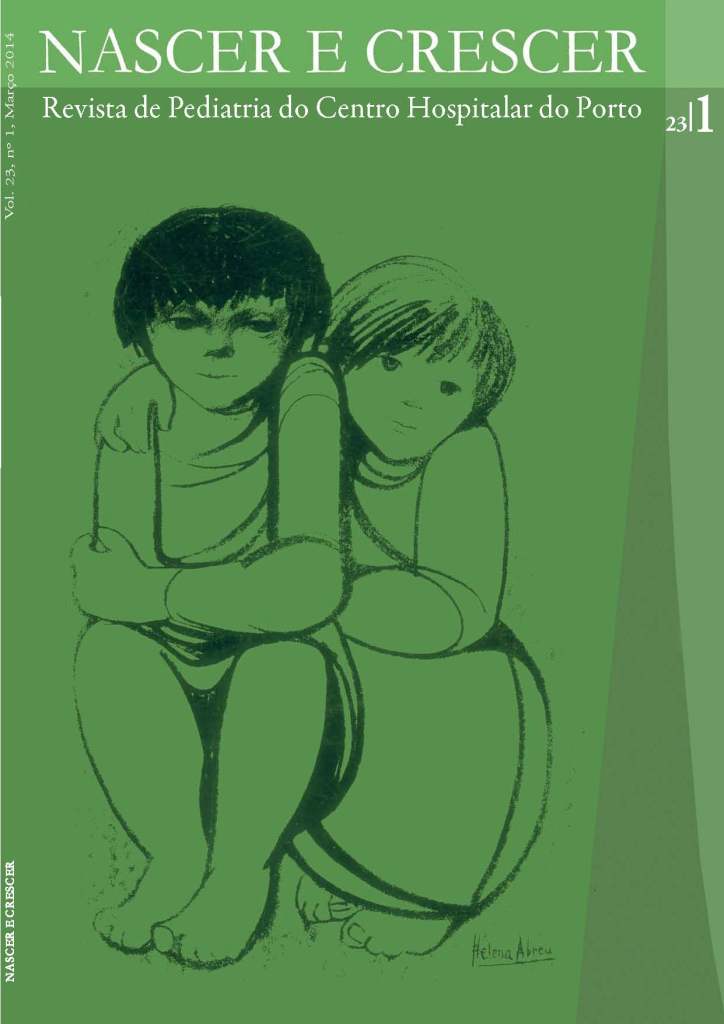Recurrent idiopathic parotitis in childhood
DOI:
https://doi.org/10.25753/BirthGrowthMJ.v23.i1.8586Keywords:
child, parotid gland, recurrent parotitisAbstract
Introduction: Recurrent idiopathic parotitis (RIP) is a frequent etiology of repeated inflammatory episodes of the parotid gland, in childhood.
Objectives: To review current literature on the etiology, clinical presentation, diagnosis and treatment of RIP.
Development: RIP is characterized by repeated episodes of swelling and pain in the parotid gland, usually accompanied by fever and malaise. Aetiology is multifactorial and, to date, unclear. Diagnosis is essentially clinical. Despite its benign character, recurrent parotitis can be a signal of other diseases, particularly in case of delayed onset of symptoms (from six -year-old) and bilateral involvement. The use of complementary tests should be individualized. Ultrasound is the diagnostic tool of choice and shows non -obstructive dilatation of glandular ducts (sialectasis). Treatment is mainly symptomatic. Prognosis is good with tendency to remission at puberty.
Conclusions: RIP is a benign and self-limited condition. However, recurrent parotitis episodes should prompt investigation for underlying diseases, particularly in cases of late onset of symptoms (after age six years) and bilateral involvement.
Downloads
References
Geterud A, Lindvall AM, Nylen O. Follow -up study of recurrent parotitis in children. Ann Otol Rhinol Laryngol 1988; 97:341 -6.
Nahlieli O, Shacham R, Shlesinger M, Eliav E. Juvenil recurrent parotitis: a new method of diagnosis and treatment. Pediatrics 2004; 114:9 -12.
Cohen HA, Gross S, Nussinovitch M, Frydman M, Varsano I. Recurrent parotitis. Arch Dis Child 1992; 67:1036 -7.
Henriques R, Salgado M, Moura L. Parotidite recorrente. Casuística da consulta externa de Medicina. Saúde infantil 2000; 22:17 -24.
Chitre VV, Premchandra DJ. Recurrent parotitis. Arch Dis Child 1997; 77:359 -63.
Capaccio P, Sigismund PE, Luca N, Marchisio P, Pignataro L. Modern management of juvenile recurrent parotitis. J Laryngol Otol 2012; 126:1254 -60.
Gordillo EO. Parotiditis aguda e recurrente. Pediatr Integral 2006; X:141 -6.
Gonçalves S, Oliveira T, Dias CP, Marques L. Parotidite recorrente na criança. Nascer e Crescer 2000; 9:14 -7.
Ceballos LT, Camacho GR, Angelín BP, Moreno JAR, Badaracco M. Parotiditis recurrente. An Pediatr 2004; 60:85 -6.
Bricks LF, Rollo JPGA, Sugimoto SC. Parotidite recorrente da infância. Rev Paul Pediatria 2007; 25:190 -2.
Oliveira MJ, Guedes M, Costa FM, Almeida R. Parotidite neonatal a Streptococcus do grupo B. Nascer e Crescer 2007; 16:233 -34.
Gadodia A, Seith A, Sharma R, Thakar A. MRI and MR sialography of juvenile recurrent parotitis. Pediatr Radiol 2010; 40:1405 -10.
Baszis K, Toib D, Cooper M, French A, White A. Recurrent parotiditis as a presentation of primary pediatric Sjögren syndrome. Pediatrics 2012; 129:e179 -82.
Hara T, Nagata M, Mizuno Y, Ura Y, Matsuo M, Ueda K. Recurrent parotid swelling in children: clinical features useful for differential diagnosis of Sjögren’s syndrome. Acta Paediatric 1992; 81:547 -9.
Oliveira WD, Assis LAP, Becker HMG, Guimarães RES, Oliveira JB, Neto ALR. Síndrome de Sjogren primária em crianças: relato de caso. Revista Brasileira de Cirurgia de Cabeça e Pescoço 2005; 34:49 -52.
Landaeta MM, Giglio MM, MS, Ulloa MTF, Martínez MJG, Pinto MEC. Aspectos clínicos, etiologia microbiana y manejo terapêutico de la parotiditis crónica recurrente infantil (PCRI). Rev Chil Pediatr 2003; 74:269 -76.
Galili D, Yitzhak M. Spontaneus regeneration of parotid salivar gland following juvenile recurrent parotitis. Oral Surg Oral Med Oral Pathol 1985; 60:605 -7.
Downloads
Published
How to Cite
Issue
Section
License
Copyright and Authors' Rights
All articles published in Nascer e Crescer - Birth and Growth Medical Journal are Open Access and comply with the requirements of funding agencies or academic institutions. For use by third parties, Nascer e Crescer - Birth and Growth Medical Journal adheres to the terms of the Creative Commons License "Attribution - Non-Commercial Use (CC-BY-NC)".
It is the author's responsibility to obtain permission to reproduce figures, tables, etc. from other publications.
Authors must submit a Conflict of Interest statement and an Authorship Form with the submission of the article. An e-mail will be sent to the corresponding author confirming receipt of the manuscript.
Authors are permitted to make their articles available in repositories at their home institutions, provided that they always indicate where the articles were published and adhere to the terms of the Creative Commons license.


